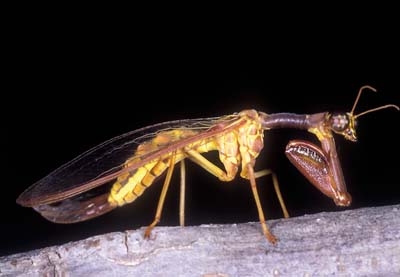
An adult mantisfly, Mantispa floridana.
(Photographer: Lyle Buss, University of Florida)
Males and females of the same species are similar in appearance. Adult mantidflies are readily identified by the elongate prothorax and raptorial front legs that resemble those of mantids. Their wings are narrow and elongate with a venation pattern similar to green lacewings. Mantidflies range in size from 20 to 35 mm, and often mimic the coloration of paper wasps.
Females deposit between 200 and 2000 stalked eggs randomly on leaves and wooden structures. Larvae often are phoretic, hitching a ride on the backs of other insects, in order to locate their prey. Mature larvae spin a cocoon and pupation occurs within the larval skin. Overwintering in some species occurs in the first instar and there may be one to several generations per year.
Adults are active predators during the day or night. Newly hatched larvae of a few species prey on scarab beetle larvae and noctuid caterpillars. Many species are predators of spider eggs. They climb onto the back of a female spider and enter the egg sac as the spider builds it. Other species are parasitic in that they attach to an adult bee or wasp, and enter the cell to feed on the developing bee or wasp larva.
Images
To save the Web-optimized images shown below to your hard drive:
|
Click to access Display and Print quality images. |
|
Click to access Display and Print quality images. |